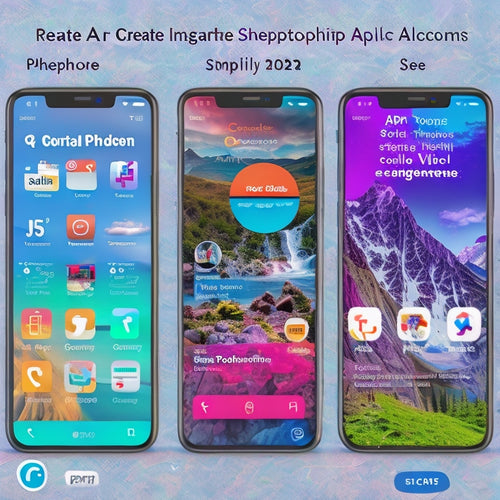
5 Essentials for Merchant Growth Through Online Courses
Share
To drive sustainable growth, you need to create online courses that tackle specific merchant pain points. Start by identifying these pain points, then define clear course objectives that provide a roadmap for success. Next, choose engaging course formats that cater to different learning styles. Develop measurable learning outcomes that define learner achievements, and guarantee seamless platform integration to enhance the overall learning experience. By focusing on these five essentials, you'll be well on your way to creating online courses that enable merchant growth – and there's more to explore when it comes to maximizing your course's potential.
Key Takeaways
• Identifying merchant pain points helps create targeted course content that addresses specific challenges, ensuring relevance and engagement.
• Defining clear course objectives sets a roadmap for success, providing a clear direction for merchants to achieve their goals.
• Incorporating engaging course formats, such as interactive activities and video tutorials, caters to different learning styles and enhances participation.
• Developing measurable learning outcomes enables merchants to track progress, evaluate course effectiveness, and achieve desired skills and knowledge.
• Seamless platform integration provides a streamlined learning experience, ensuring compatibility, flexibility, and real-time data insights for course improvement.
Identifying Merchant Pain Points
As you explore the world of online courses, understanding the specific challenges that hinder you from achieving your goals as a merchant is vital. You're not alone in facing obstacles that limit your growth and profitability. Many merchants struggle with similar pain points, such as managing inventory, staying current with market trends, and effectively marketing products.
These merchant challenges can be overwhelming, but they don't have to hold you back.
To overcome these hurdles, it's necessary to identify the specific areas where you need improvement. Take a closer look at your operations, sales strategies, and customer engagement. Are there inefficiencies in your supply chain? Are you struggling to connect with your target audience?
Defining Course Objectives Clearly
Now that you've identified your pain points, you're ready to define clear goals for your online course, which will serve as a roadmap for achieving the growth and profitability you desire.
This is an essential step in creating a successful course, as it helps you stay focused on what you want to achieve and guarantees you're measuring progress effectively. By setting clear goals, you're setting expectations for what you want to accomplish, and this will help you create a structured course that delivers results.
When defining your goals, make sure they're specific, measurable, and attainable. This will enable you to align your goals with the content of your course, making sure you're tracking success and making adjustments as needed.
Choosing Engaging Course Formats
You'll greatly improve learner engagement by selecting course formats that cater to different learning styles and preferences, thereby increasing the overall effectiveness of your online course. By incorporating a mix of formats, you'll appeal to visual, auditory, and kinesthetic learners, ensuring that your course resonates with a broader audience.
Interactive activities, such as quizzes, gamification, and discussions, are excellent ways to encourage learner participation and foster a sense of community. These formats allow learners to engage with the material in a more dynamic way, making the learning experience more enjoyable and immersive.
Video tutorials, on the other hand, provide an opportunity to demonstrate complex concepts in a clear and concise manner. By combining these formats, you'll create a engaging and informative learning experience that caters to diverse learning needs. Remember, the key is to strike a balance between different formats to keep learners engaged and motivated throughout the course.
Developing Measurable Learning Outcomes
By crafting clear and measurable learning outcomes, you're able to define what learners will achieve by completing your online course, providing a roadmap for both you and your learners to track progress and success. This roadmap enables you to assess performance and identify areas where learners may need additional support. When learning outcomes are specific, measurable, achievable, relevant, and time-bound (SMART), you can create targeted content that guarantees learners meet the desired outcomes.
Measurable learning outcomes also help you track progress and evaluate the effectiveness of your course. You can use metrics such as completion rates, quiz scores, and learner feedback to refine your course and improve learner engagement. By setting clear expectations, you can guarantee learners stay motivated and focused on achieving the desired outcomes.
Furthermore, measurable learning outcomes provide a clear return on investment for your learners, as they can see the tangible benefits of completing your course. By developing measurable learning outcomes, you're taking the first step towards creating a high-impact online course that drives real results for your learners.
Ensuring Seamless Platform Integration
Effective online course delivery relies on seamless platform integration, which enables learners to access your course content effortlessly, reducing technical distractions and enhancing their overall learning experience. As a merchant, you want to guarantee that your online course platform integrates smoothly with your existing systems, allowing you to focus on what matters most - growing your business.
To achieve this, you need to develop effective integration strategies that prioritize platform compatibility. Here are some key considerations:
| Integration Strategy | Platform Compatibility | Benefits |
|---|---|---|
| API Integration | LMS, CRM, and Website | Scalable and flexible integration |
| Single Sign-On (SSO) | LMS, Website, and Mobile App | Seamless user experience |
| Data Syncing | CRM, Marketing Automation, and Analytics | Real-time data insights |
| Microservices Architecture | Modular and Flexible Platform | Increased reliability and scalability |
| Third-Party Integrations | Payment Gateways, Email Marketing, and more | Expanded functionality and reach |
Frequently Asked Questions
How Do I Ensure Consistent Branding Across All Online Course Materials?
'Your brand identity is like a thread that weaves a tapestry; maintain consistent branding across online course materials by upholding visual consistency in logos, color schemes, and typography, so your message shines through clearly and cohesively.'
Can I Use Existing Content to Create an Online Course Quickly?
You can repurpose existing content to create an online course quickly by identifying relevant assets, organizing them into modules, and filling gaps with new material, using reuse content and time-saving strategies to accelerate development.
What Is the Ideal Course Length for Maximum Merchant Engagement?
You're stuck between a passing look and an in-depth exploration - what's the ideal course length for maximum engagement? Aim for 30-60 minutes per module, balancing concise engagement strategies with learning outcomes that boost student retention.
How Do I Handle Technical Issues During Live Online Course Sessions?
When technical issues arise during live sessions, you'll need to act fast to minimize disruptions. Implement troubleshooting strategies to quickly resolve problems, and consider having a dedicated tech support team on standby to guarantee participant engagement isn't compromised.
Are Online Courses Suitable for Merchants With Limited Computer Skills?
You might wonder if online courses are suitable for you with limited computer skills. The good news is that you can adapt, and online learning is designed to accommodate varying levels of computer literacy, making it accessible to everyone.
Related Posts
-
Enhancing E-Commerce With Interactive Shoppable Videos
Interactive shoppable videos have revolutionized the e-commerce landscape, offering businesses a powerful tool to enh...
-

Top Social Media Apps for Shopify in 2023: Boost Your Brand's Reach and Sales
This article explores the top social media apps for Shopify in 2023 and their significance in enhancing brand reach ...
-

Optimizing Shopify Speed: Tips for Faster Performance
This article aims to provide a comprehensive guide for optimizing the speed of Shopify websites. It discusses the bu...

